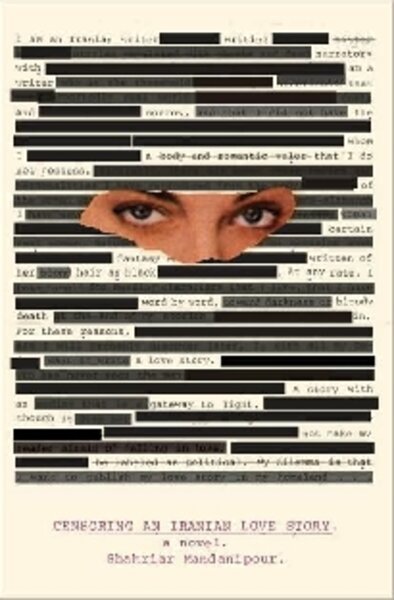Censoring an Iranian Love Story
Loading...
It’s your typical love story: Boy sees Girl’s shoes under a card catalog at the library. Boy falls in love with Girl and writes her coded letters in books. Writer goes nuts trying to pen a love scene in a country where Boy and Girl can’t legally be together, either in public or private. Then the corpse of a hunchback dwarf shows up.
In Censoring an Iranian Love Story, the first novel to be published in English by Iranian writer Shahriar Mandanipour, the first word of the title is the one that should govern a reader’s expectations. If you’re looking for a tale of love triumphing over all obstacles (and by gum, are there obstacles) or a Middle Eastern Romeo and Juliet, seek elsewhere.
If you like the intellectual challenge of the metafiction of J.M. Coetzee or Paul Auster, or the sheer spiraling loopiness of Charlie Kaufman films such as “Adaptation,” then grab a copy and prepare to enjoy a meditation on culture, modern Iran, and the power of what is left out. Oh, and make sure you read all the crossed-out lines: There’s some pretty pivotal information hiding under there.
As with “Adaptation,” Mandanipour’s main character is named Shahriar Mandanipour, a novelist who’s having a horrible time writing a “simple love story.” “I am an Iranian writer, tired of writing dark and bitter stories, stories populated by ghosts and dead narrators with predictable endings of death and destruction.”
But rebuilding a motorcycle engine underwater while blindfolded might be easier than constructing a happy ending. His problem isn’t writer’s block – it’s the difficulty of trying to find ways to outsmart the government censor, whom he nicknames Porfiry Petrovich (the detective who pursues Raskolnikov in “Crime and Punishment”), who has the tendency to show up at the most inconvenient times. Also, his characters won’t do what he tells them.
As Mandanipour rewrites different scenes, frantically crosses out lines, and explains cultural references from 700-year-old ghazals to the Al Pacino film “Scent of a Woman” (good luck getting that title past the Iranian censors), he is instructing a Western reader in the art of the unwritten. The ellipsis, we are given to understand, is one of the most powerful tools of a reader operating under censorship.
“When Sara reads a contemporary story, she reads the white between the lines, and wherever a sentence is left incomplete and ends with three dots like this ‘...,’ her mind grows very active and begins to imagine what the eliminated words may be. At times, her imagination goes farther and grows more naked than the words the writer had in mind. If she is as clever as an intelligence agent and has the power to decipher the codes that lie in the shadows of the petrified phrases and in the hidden whispers of the conservative words of Iran’s contemporary literature, she will find the very things she likes. Sara loves these three dots because they allow her to be writer, too....”
Sara and Dara (I know, but apparently they were the equivalent of Dick and Jane in prerevolutionary Iran) are our ostensible lovers. She’s a middle-class university student studying Iranian literature, even though teaching contemporary Iranian literature is forbidden. He’s a former political prisoner who ekes out a living painting houses. Before his arrest, he was a film student, whose dreams of being the next Abbas Kiarostami were destroyed by prison.
Later, he spent seven months in solitary confinement for selling banned Western movies, including “Snow White and the Seven Dwarves.” Dara doesn’t help his cause when he tries to explain that he’s only selling the classics of modern cinema, and his interrogator misunderstands and thinks that Dara is admitting that there are coded messages hidden inside.
The hunchback dwarf I can’t explain, but he pops up periodically, befuddling everyone. There are also poets’ ghosts, a seller of magic charms, a phantom assassin, and Mandanipour himself, who occasionally steps in to help out the would-be lovers – or key a character’s BMW. And of course, there’s Petrovich, tsking away at Mandanipour’s moral turpitude, but possibly fascinated in spite of himself. The conversations between Mandanipour and Petrovich are far more fraught than anything the star-crossed lovers could come up with. (Mandanipour, who currently teaches at Harvard, was unable to publish in his native country for much of the 1990s.)
Dara also isn’t that impressed by his creator: At one point Sara and Dara are talking about one of Mandanipour’s short stories, and Dara sniffs that it’s “cowardly.” “The writer has played tricks to pass censorship. I don’t like a writer who plays tricks. A writer who can trick the censorship apparatus can trick his readers, too.” For readers who also prefer a more upfront literary style, be warned: Mandanipour pulls everything but a rabbit out of his hat.
But then, Byron and Shakespeare never had to operate under these conditions.
Mandanipour can’t describe his female character’s beauty without using produce metaphors (there are so many pomegranate references that he says he feels like a still-life painter) and his main characters can be beaten and arrested for walking down the street together. So creativity is the order of the day. One of Sara’s and Dara’s dates takes place in an emergency room of a hospital; another time they arrange to meet walking into a mosque.
But their efforts to see each other are nowhere near as convoluted as Mandanipour’s efforts to write about them. By the end of this witty, hyper-intelligent riff on life under a repressive regime, the exhausted writer has demonstrated the mental and emotional contortions necessary to survive and fully convinced a reader of this vast understatement: “publishing a love story in Iran is not a simple undertaking.”
Yvonne Zipp regularly reviews fiction for the Monitor.






